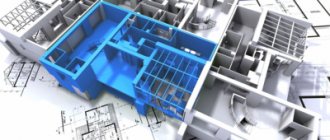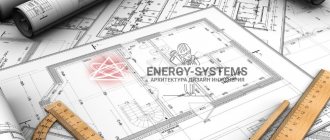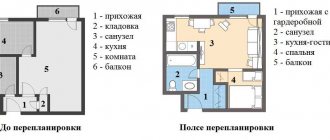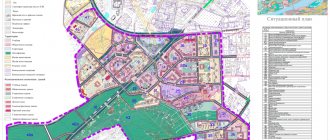What is an apartment redevelopment project?
If you have started a redevelopment, then most likely the experts will tell you that you need to do a project.
An apartment redevelopment project is design documentation that contains a plan for future work, layouts of premises before and after renovation, as well as various drawings, explanations and calculations for changing the configuration of the apartment. Simply put, these are filed sheets with a plan for the redevelopment of the apartment, on the basis of which officials will approve the renovation.
The requirements for projects in Moscow can be found in Appendix 3 to Moscow PP No. 1335-PP dated August 19, 2021 (previous requirements were in Moscow PP No. 508-PP dated October 25, 2011).
Local regulations apply in regions. For example, in Kazan, the Administrative Regulations can be found on the portal of local government bodies of the city of Kazan.
Along with the redevelopment project, a technical opinion may also be required. It is an annex to the project and reflects two important points: what condition the building’s structures are in and whether redevelopment can be done without the threat of collapse of these structures. For example, in Moscow they always require a project + technical report. In the regions this is easier and they may only ask you for design documentation.
Plans and schemes
Schemes and plans for documentation of a redevelopment project are a mandatory component , since they confirm not only qualitatively the possibility of redevelopment, but also quantitatively the legality and compliance with standards, GOSTs, etc.
Drawing before
It is drawn according to the floor plan available in the BTI, therefore it must completely coincide with it according to the inventory data.
In some cases, can a table of apartment explications with the BTI plan itself be used? for example, when transferring to a non-residential property.
Dismantling and installation markings
Using color markings, the location of changeable objects before redevelopment is drawn in green : plumbing fixtures, load-bearing partitions, openings, etc., and their planned movement is shown in red.
Activities after
Without using color designations, a new diagram is drawn in the form of a plan for the location of the premises, and a new explanation is attached to the paper, which shows the purpose and changed areas of the apartment’s premises.
The installation of large household appliances is indicated only if there are appropriate marks in the original BTI plan. When the customer receives a certificate of completion of housing reconstruction, BTI employees make control measurements , which are included in the new documents from BTI for the apartment.
Important! If necessary, additional sections are included in the project.
Explication of floors
Explication of floors is included in the project subject to intervention in the design of the flooring . For each room, the explication indicates a floor plan - their layer-by-layer construction. The attached plan indicates the boundaries for different types of floors. In a residential building, sound insulation must be installed on the floors, and waterproofing is required for the bathroom and toilet.
If the flooring is routinely replaced with a material of a similar type, for example, parquet is laid instead of boards or laminate, then the reconstruction of the floor is not considered an intervention in the structure, but replacement with ceramic tiles or electric heating flooring is.
Waterproofing
When changing the size of the bathroom, it is necessary to install waterproofing under the flooring.
These changes will be reflected in hidden work reports , indicating the lowering of the floor in the room or the installation of an overflow threshold.
Sewerage and water supply
Relocation of piping patterns, which is caused by a change in the location of plumbing equipment, requires reflection in the project documentation. This section can be drawn up separately from the project or included in it; it contains color-coded drawings of the layout of sewer pipes and cold/hot water supply systems.
Engineering equipment
Displays the layout of heating, ventilation and plumbing in the apartment. This section is not always included in the project, since it is closely related to the ventilation and heating plan, as well as to the sewerage and water supply plan. The requirement for its presence in the documentation is due to the need to confirm the absence of any changes to the engineering systems.
Axonometry
These drawings are used for greater clarity of the three-dimensional display of ventilation shafts , water supply and sewerage pipelines, and therefore are produced in color.
Strengthening load-bearing structures
In a redevelopment project, it is present when carrying out work on equipment in unloading or load-bearing walls or ceilings of openings. They also reflect work on moving or expanding existing openings of these structures. Contains a diagram of metal structures, parameters of openings, and the presence of additional reinforcement.
Reference! Sometimes the project includes recommendations on the rules for carrying out such work, indicating the details of components and specifications of materials.
Instructions for cutting the opening and installing metal profiles
Describes the requirements and instructions for cutting an opening, safety rules for such work, requirements for the tools and materials used. Responsibility for the quality of this operation rests with the design organization, which must allocate a competent employee for designer supervision and drawing up an act for hidden work. All operations prior to plastering are included.
Should the installation of non-load-bearing interior partitions made of gypsum plasterboard or foam blocks be included?
Indicated if there is a standard diagram of partitions made of foamed aerated concrete and diagrams for the installation of load-bearing frame partitions.
Ventilation and heating
The design documentation is included when non-standard solutions are implemented in terms of ventilation and heating . Contains drawings and axonometry.
Electricity supply
Most often required for apartments located in new buildings. For other real estate objects, it is included in the project if there are significant changes in the location of wiring, switches, lighting fixtures, installation of equipment with a power of more than 1 W, etc.
Photomontages
Needed when carrying out facade work for coordination with the district administration authorities. In accordance with the design decision, photomontage is carried out before and after the work is completed .
Attention! Approvals and marks do not require the installation of air conditioners and glazing of loggias.
Thermal calculation
It can also be called the calculation of heat transfer of enclosing structures; the redevelopment project is included in the case of construction and repair work on the external panels of the building.
When increasing the doorway to a loggia or balcony, removing a window sill block or other changes can reduce the ability to maintain the standard temperature level in the apartment.
Using this document, it is necessary to confirm the absence of significant changes and guarantee that the standard temperature regime will be maintained .
Acoustic performance
The installation of a new ventilation system must comply with noise emission standards, which is reflected in the corresponding section of the project.
When is a project needed?
Almost any changes in the configuration of a residential premises require the owner to provide a redevelopment project.
We are talking about work that results in changes to the original BTI plan. The project is needed to show the administration what you want to do, what materials will be used, how the load on the supporting structures will change, etc.
What kind of work requires an apartment redevelopment project:
- Construction of openings in load-bearing walls (with reinforcement).
- Expansion of the bathroom due to the area of the corridor.
- Increasing the kitchen area at the expense of the room.
- Dismantling the window sill.
- Demolition, replacement or creation of partitions between rooms, for example, a bathroom and a toilet.
- Combination of room and corridor.
- Creating a dressing room, for example, after dismantling the built-in wardrobes.
- Replacement of floor coverings.
- Replacing a shower stall with a bathtub.
- Other works.
Before carrying out this work, you need to draw up a project and submit it for consideration to the architectural department of the city or district. But in some cases, you can get by with a sketch or not draw up design documentation at all. For example, when you want to make cosmetic repairs, hang wallpaper, install plastic windows or a home air conditioner.
Is it possible to get by with a sketch?
The sketch is suitable in cases where changes in the apartment plan are not so serious. They do not need to be included in the BTI plans.
For example, you move plumbing fixtures within a bathroom, but the area of the room does not change. Or you are planning to dismantle the old built-in wardrobes - the dimensions of the corridor also remain the same.
Coordinating redevelopment “according to a sketch” is much simpler and cheaper. The main difference from a project is that first you carry out the work, and only after its completion do you draw up a sketch (directly on the BTI plan). Next, it is assessed in the architecture department, a technician comes to you and checks the work done with the sketch. If everything is in order, all that remains is to record the changes in the BTI and the Unified State Register.
Coordination of redevelopment of non-residential premises
Redevelopment of an apartment through the MFC
Stages of redevelopment
After receiving all permits, drawing up a project and developing a design, it is time to carry out redevelopment work.
Important to know! The “zero” stage of redevelopment is the complete emptying of the apartment from furniture and all other things, since during the renovation they will interfere with the work and be subject to harmful influences. Constantly moving furniture can cause damage or deformation. Construction companies generally do not provide compensation for such damage.
Further actions to carry out the work can be divided into three main stages. The first stage is moving the partitions and creating holes for new doors or other structural parts. At this stage the following is carried out:
- Dismantling old partitions.
- Cleaning and removal of the resulting debris.
- Installation of new partitions.
- Creation of a cement screed.
- Installation of electrical wiring.
Also, error correction is carried out, namely, the alignment of walls and ceilings. Then, windows and ventilation systems are installed, since they often require the installation of additional communications. If the plan involves changes in the bathroom and toilet area, the floor should be waterproofed and plumbing work carried out.
At the second stage, final electrical and plumbing work is carried out:
- Distribution boxes are installed.
- A bathtub, sink, toilet and other plumbing fixtures are installed.
- After leveling the walls, tiling work is carried out in the designated areas.
At the third stage, all cosmetic work is carried out, thanks to which the apartment takes on a residential appearance:
- Uneven surfaces are finally leveled and puttied.
- Painting work is being carried out.
- The flooring is being laid.
- Wallpaper is glued to the walls.
- Electrical fittings are being installed.
- Doors are being installed.
After this, it is necessary to clean the apartment and further design work related to the placement of furniture and ensuring a comfortable space.
It is recommended to entrust the development of a design project to professional designers. This will allow you to decorate the room in the same style with the maximum level of comfort and ergonomics.
The final stage of redevelopment
Typical redevelopment project
It is used in cases where work can be carried out on the basis of ready-made redevelopment projects from the author of the house. There is no need to order a paid project from an SRO organization.
A standard redevelopment project is always free. It can be found on the official website of the author of the house, in the catalog of finished projects. For example, in Moscow, most residential buildings were designed by JSC MNIITEP. Standard projects can be downloaded from the catalog on the official website of the Moscow Housing Inspectorate.
If your house belongs to a mass series of houses, the layout of the apartment is exactly as in the catalog and you liked one of the standard redevelopment projects, you can safely use it. A link to the selected project must be sent to the local government when submitting other documents for approval of configuration changes.
Important! The disadvantage is the template nature of standard projects. You won’t be able to change them to suit your tastes and ideas. The slightest deviation from the project will lead to the commission not accepting your work, which means you will have to redo it in accordance with the standard project.
Are you tired of reading? We’ll tell you over the phone and answer your questions.
Where and how to order a project?
Always act in accordance with the Housing Code of the Russian Federation. The ideal option is to contact the organization that designed the house. However, this possibility is not always available. Therefore, when planning an apartment redevelopment project, you will need the help of experts. They will prepare a standard project and check it for compliance with SNiP, sanitary and hygienic and other standards. The cost of services will depend on the complexity. If you plan to work with load-bearing structures, the task will be more difficult.
Housing in a new building often needs to be modified. The apartment is for rent in a rough finish, without some communications or partitions. Often, developers allow buyers to determine the interior design themselves. It is agreed upon and the necessary work is carried out. Then homeowners are issued an apartment passport, and the facility is put into operation.
When contacting engineering and design organizations, always check their documents. The company must be licensed and have permits. Otherwise, the project she prepared will be rejected. Professionals will do everything quickly, legally and technically correctly. You won't have to pay twice.
A reliable option would be to contact a company that performs major repairs. When ordering it, the service of creating a layout is free for the client. The company's architect will be able to advise you professionally. After agreeing on the redevelopment, specialists will repair your apartment in accordance with the requirements of SNiP and other regulations, providing a guarantee for their work. Thus, you solve several problems at once, collaborating with one contractor.
Where to make an apartment redevelopment project for approval
To order an apartment redevelopment project, you need to contact a commercial company that has SRO approval to produce project documentation.
You can find out whether the company is listed in the register of designers on the Nostroy website. Pay attention to the last column "Status". If there is a green checkmark next to the company you have chosen and the status is “Active”, then you can apply for a project to this company, which means the opposite - the company is not listed in the SRO register. The project she draws up will be invalid and it will not be accepted anywhere.
How to order
Let's look at the stages of ordering an apartment redevelopment project:
- Check that the designer is a member of the SRO and has permission to provide services. The company must have an SRO certificate (license), as well as an enhanced qualified signature.
- Contact the designer's representatives: by phone, e-mail, through the website, by registered mail or in person in the office.
- Consult with an engineer to see if it is possible to implement your redevelopment idea in practice. Perhaps something will have to change as discussions progress.
- Sign an agreement for the provision of services for drawing up a redevelopment project and a technical report. The contract will protect your rights in case disputes arise regarding the revision or rejection of the project. One contract will remain with the company, and the second copy will be given to you. An author's supervision contract will also be signed. It is needed so that the designer checks the hidden work and draws up the appropriate act. For example, about waterproofing floors in the bathroom or soundproofing in the bedroom. Without these acts, the inspection authorities from the administration will not accept work from you.
- Make an advance payment to start developing the project. The rest of the amount will need to be paid upon successful acceptance of the apartment redevelopment.
- Submit the necessary documents to the company and wait for the project to be ready.
If you don’t want to coordinate repairs with different authorities, you can entrust this to a turnkey designer. The service costs more. But on the other hand, you won’t have to communicate with officials and ask for permission—this will be handled by representatives by proxy.
What is considered a redevelopment?
During a comprehensive renovation of an apartment, there is often a need to add, remove, or move something. Such radical changes require not only complex calculations, but also documented permission.
People confuse a design project and a plan for changing the layout of a room. What is the difference? In the first case, we are talking about changes that do not require permission. This means changing the range, updating the finish, replacing lighting fixtures. New windows, doors, parquet or laminate flooring can also be installed. The customer and designer discuss the choice of materials and overall design. When creating a design project, drawings and 3D visualization are used.
If the task is to change the internal space - expand it, install or demolish partitions - you must obtain permission. The Housing Code of the Russian Federation gives a precise interpretation of this concept. In Art. 24 states that redevelopment is considered to be changes in the configuration of the premises that must be included in the technical passport. There are other laws and regulations that expand this definition. In particular, they talk about moving and dismantling doorways and expanding rooms to include other rooms, installing additional bathrooms and kitchens.
But let's get back to where we started. A design project is a beautiful marketing picture that you should like. How well the result complies with building codes and requirements is unknown. Therefore, it can only be used as a basis for drawing up a future redevelopment project. It is important that a specification be drawn up for it and an explanatory note be prepared. It contains information on materials used during repairs: type, quantity, characteristics, approximate cost. The explanatory note describes in detail the concept of the prepared project. It contains the functional, technical and aesthetic nuances of the developed design.
Complete turnkey apartment renovation
- Everything is included The cost of repairs includes everything: work, materials, documents.
- Without your participation After agreeing on the project, we only bother the owners when the repairs are completed.
- The price is known in advance. The cost of repairs is fixed in the contract.
- Fixed repair period Turnkey apartment renovation in 3.5 months. The term is fixed in the contract.
Read more about Done
Remember that having good specialists in the field of 3D modeling and design does not mean that the company will be able to prepare a project approved by inspection organizations. A common phenomenon is technological violations, which are easily identified during the first inspection. Sometimes unprofessionalism in the engineering field can lead to emergency situations. Then ordinary repairs turn into eliminating the consequences of such negligence. If there are many violations, you will pay a fine, and the Housing Inspectorate will oblige you to return everything to its place. You will have to do this at your own expense and quickly. Violations of SNiP are always subject to strict sanctions.
The reason for such situations is that any company can create a design project. She is not legally responsible for the compliance of the result with the standards. There are no licensing requirements for such activities. For comparison, a redevelopment project always has legal force, has been approved by the supervisory authorities, and has been developed by specialists who have certificates of admission to such work. By contacting them, you are sure that the redevelopment will be approved without problems or with minimal changes.
The ideal option is to contact a reliable construction company, from which you can not only get professional advice from an architect on redevelopment, but also order high-quality major repairs after its approval. This way you will save time, money and nerves.
Composition of the redevelopment project
Requirements for the preparation and composition of the project have been approved throughout the Russian Federation. Designers are aware of the regulations, so project customers do not have to worry about the correctness of the structure.
Nevertheless, we suggest that you familiarize yourself with what sections the redevelopment project consists of:
Section 1. Cover and title page - combined or separate sheets
The cover includes the design organization's header, address and other contact information. The name of the project is indicated in the center. Below is the address of the apartment where changes are planned. At the very bottom of the sheet is the city and year the project was made.
The title page is needed for signatures of responsible persons. Usually this is the director or head of the design company, as well as the chief engineer. The organization's seal is also placed here.
Section 2. General information
Includes the following information:
- Table of contents: what sections the project consists of, what pages they are on and how many sheets they occupy;
- The list of documents attached to the project includes BTI plans, copies of the designer’s license, designer’s supervision;
- A table with links to legal and local acts in the text of the project itself (SNiPs, GOSTs, regulations, etc.);
- In the lower left corner is the commitment of the chief project engineer (PI) on the compliance of technical solutions in the project with legal requirements, indicating the initials of the PI.
Section 3. Explanatory note of the project
Contains a detailed list of necessary work within the framework of the required project. The following are important terms and conditions that must be observed. For example, the use of specific materials for laying waterproofing, arranging a threshold in a bathroom doorway, etc.
Section 4. Residential plan before redevelopment
The basis is always the BTI plan and explication of the premises “before” the renovation. The numbering and letters must comply with the technical documentation of the BTI, without deviations. Otherwise, the hosts may refuse to approve the project.
Section 5. Dismantling and installation plan
Here the engineer indicates all the changes that are planned during the redevelopment of the apartment. For example, demolishing a partition, creating an opening in a load-bearing wall, erecting new walls, etc.
On a note! Color schemes are used in this section. Usually two colors are used: green and red. Green indicates installation and red indicates dismantling. However, there are no strict requirements for the color scheme in GOST, but in practice these two colors are used.
Section 6. Apartment plan after redevelopment
The final version of the living space, taking into account the implementation of all technical solutions.
There are two tables on the sheet:
- Plan – is a drawing of the apartment indicating the dimensions of the premises;
- Explication - gives a detailed description of all the premises presented (kitchen, living room, toilet, etc.)
This version of the apartment will be accepted by a commission from the architecture department or housing inspection. The final dimensions will be recorded by a BTI engineer, and subsequently changes will be made to the technical passport of the residential premises.
Section 7. Floor plan
This sheet is hemmed only when the floor coverings are changed, which does not happen with every redevelopment.
There are also two tables on the sheet:
- Floor plan - a drawing of an apartment with a designation of the surface in each room;
- Explication - drawing out diagrams, indicating the type of flooring, material and area (sq. meters).
Below are symbols and an “inset” to identify the page as part of the project.
Section 8. Waterproofing and sound insulation scheme
Required when expanding the area of rooms or installing floor coverings. The waterproofing unit protects against moisture penetration to the base of the floors, which means it protects the neighbors below from flooding. Sound insulation (sound insulation) is needed so that the same neighbors do not go crazy from loud sounds in your apartment.
The sheet shows the plan, explication and diagram of the protection device. The section is supplemented by acts of hidden work, which must be signed by the designer with SRO approval.
Section 9. Apartment plan with plumbing equipment
Mandatory in the case of moving batteries, water supply risers, drainage pipes or ventilation units. If apart from these works you have done nothing else, then such a plan can proceed as an independent one. The main project will no longer be needed.
Section 10. Axonometric diagrams of hot water supply and cold water supply
Three-dimensional diagrams of laying connections for all types of communications to plumbing equipment (cold and hot water supply) are drawn on the sheet.
Section 11. Strengthening load-bearing structures
A mandatory section if you are touching load-bearing walls in an apartment, for example, make an opening in them.
Reinforcement is always done using metal structures. Accordingly, in the plan it is necessary to note the reinforcement drawing (dimensions, frame, spacer posts, specification). There is also the order of work - a description of the steps, and what follows what.
Such processes are accompanied by acts of hidden work, that is, strengthening of openings in the load-bearing wall. At the same time, it is necessary to contact the author of the house for a technical opinion on the condition of the building’s structures. In Moscow, these conclusions are issued by MNIITEP.
Section 12. Scheme of installation/dismantling of partitions
The material and method of attaching partitions to the floor and walls are indicated.
Below is the calculation formula: time of load on the floor, weight of the partition, maximum load and engineer’s conclusion. The maximum and minimum load on the floors is taken from GOST and SNiPs.
Section 13. Plan and photographic recording
Here you need to mark on the map the location of the house in the city. A small section of the map is enough where other houses, street names, roads and other objects are visible. Below is a color photo of the house.
Section 14. Permission from SRO to carry out work
The organization that draws up the redevelopment project attaches a Certificate of Permission to Work to it. It confirms that the company has the right to develop projects taking into account the safety of capital construction projects.
Another mandatory application is architectural supervision - so that the designer can sign acts of hidden work.
Redevelopment "Light" as an alternative option
Sometimes owners remodel an apartment without urgent need. This often leads to large material costs and discomfort during such work, and also takes a lot of time.
It should be noted that inconvenience in the room is often caused not by limited space, but by incorrect distribution of functional areas in the apartment and unsuccessful interior design. In this case, the redevelopment will most likely not bring the desired result due to the fact that the apartment space will again be used inefficiently.
As an alternative, you should resort to a simplified redevelopment option, which does not require either a lot of paperwork or large-scale construction work. We are talking about creating a comfortable ergonomic environment by redistributing the space of various functional areas of the apartment.
It is solely through the correct distribution and functionality of the space in your home that you can achieve the desired effect. To turn even the most standard and not very comfortable apartment into a comfortable space, professional designers use the following solutions:
- Replacement of furniture.
- Changing its location.
- Ergonomics calculation.
When it comes to lighting or the feeling of being cramped, professional design solutions can also be very helpful. They allow you to visually make a room more spacious, lighter or darker without significant investments or major reconstruction work.
Living room after designer redevelopment
What an apartment redevelopment project looks like: sample
Below you can see an example of a redevelopment project:
Technical passport of residential premises
A technical passport of a residential premises is a document that contains all the technical data of the premises. The technical passport is drawn up during the initial inventory, which is carried out when a new house is put into operation. It is not the developer, but the owner of the residential premises, who is responsible for the preparation of the document.
The data sheet contains the following information:
- floor plan of the living space;
- inventory value of the premises;
- what materials are the walls made of?
- main characteristics of floors and foundations;
- when was the housing built;
- how many rooms are there;
- its footage, etc.
A registration certificate for residential premises is required when making transactions for the alienation of premises, to coordinate reconstruction or redevelopment, to allocate a share in kind in shared ownership, and also to establish the amount of tax on residential premises. In addition, the technical passport of the premises will also be needed when registering an inheritance.
Documents for drafting
The design bureau usually asks to provide:
- BTI technical passport - consists of a floor plan and explication;
- design project for future redevelopment (available);
- documents for the apartment - an extract from the Unified State Register or a certificate of registration of ownership.
If during repair work you plan to affect common property, in addition to the package of documents, you also need a protocol of the meeting of homeowners. And when affecting the facade of a building, permission from the Moscow Committee for Architecture (regions may have their own authorities).
What it is
The owner does not always understand the essence of the project and confuses it with design developments. Redevelopment often has a strong impact on the infrastructure and interior, so at the same time sketches and drawings of a new look for the premises are created.
However, the design project will be useful in the future, when the main dismantling and installation work comes to an end. At this time, they begin finishing, adhering to the chosen style and color scheme. In addition, the developed ideas will be partially affected and included in the project documentation.
Carrying out reconstruction will become almost impossible if the provisions of a number of regulations and laws adopted at the governmental and regional level are violated.
The following are prohibited:
- dismantling load-bearing structures or punching holes in them for door and window openings;
- transfer of a bathroom and bathtub to an adjacent room without waterproofing the floor;
- combining the kitchen with a room or corridor, especially if a gas stove is installed (it should be separated by a wall with a door);
- installation of a fireplace if it is a panel house;
- replacement and relocation of risers along with other communication systems (they cannot be hidden, since it is important to ensure constant access for inspection and repair);
- expansion of the room due to the loggia and balcony, especially when installing a radiator there (exceptions are made for the first floor, but without radiators).
True, in some cases they can meet halfway if certain conditions are met. To do this, you will have to begin the approval procedure, starting with family members, registered residents, the management company or the municipality, if a social rental agreement has been concluded.
For small changes, it is enough to prepare sketches, as specified in the regulations.
They are prepared by:
- replacement of plumbing fixtures, pipes and wiring;
- dismantling partitions if they are not considered load-bearing and delimit separate rooms;
- installing a fireplace on the top floor, when a high-quality chimney is installed;
- expanding the kitchen at the expense of neighboring rooms while maintaining space, ensuring insolation and ventilation.
Before you begin redevelopment, you need to clearly understand the work plan and the end result.
It would definitely be a good idea to consult with a lawyer or one of the regulatory agencies. Approvals involve at least the local housing inspection, architectural department and BTI.
After receiving answers to your questions, it will be possible to create a concept that will be embodied in the prepared project.
What is the price
The exact cost of the apartment redevelopment project will be told to you directly at the design office.
The average price of projects in Moscow is from 15,000 to 40,000 rubles. The technical report is either included in the cost of the project or paid separately. If load-bearing walls are affected, then in Moscow you need to obtain a technical report from the author of the house (MNIITEP). The cost is quite high - 70,000 rubles.
Design bureaus can offer services for coordinating turnkey redevelopment. Payment will be higher than for one project without approval from the administration. The cost of support ranges from 40,000 to 90,000 rubles.
Approval procedure
The approval process is quite regulated and you need to follow a certain procedure:
- Instead of looking for standard options, it is better to choose a design office that has permission and a license to conclude an agreement.
- The demolition of some structural elements in a newly completed house is impossible without the permission of the authors in the person of the designer or architect.
- Designers will need a technical passport, floor plan, real estate documents and permission from the housing inspection to begin detailed development.
- To obtain permission, you will need the same passport and certificate of ownership, along with a prepared application and a project outlining the redevelopment plan.
- The application contains personal information about the owner and landlord, a short description of the project, and expresses a request for redevelopment, supported by the consent of the residents.
- Attached is an extract about the composition of the family or a house register, a copy of the personal account and a report from the fire department and consumer inspection.
- The review usually takes place in the housing inspection or architectural department and takes from 2 to 4 months, which depends on the region and the complexity of the redevelopment. Submitting papers from the designers themselves helps shorten the review process.
- The project itself must receive approval from the gas and fire services, the SES, and the monument protection authority if the house represents cultural heritage.
- The completion of approvals and the issuance of permits will allow for reconstruction, which will take up to four months. Deviations from documentation are simply unacceptable.
- After completion of the work, an inspector or commission conducts an inspection to draw up a report and confirm that the alterations comply with the approved project.
- Changes must be reflected in the technical passport. To do this, you need to come to the BTI with your passport, project, permit and certificate of completion of work.
- The same papers are submitted to the cadastral chamber in order to amend the accounting and receive a new document. If the area changes, a certificate of ownership is issued again instead of the old one.
Carrying out unauthorized redevelopment is fraught with not only fines. It is possible that the court will decide to restore the apartment to its original form.
Is it possible to make an apartment redevelopment project yourself?
It can be developed, but it cannot be agreed upon.
We are talking about cases when a project and a technical report are needed to redevelop an apartment. We found out that only organizations that have permission from the SRO to carry out design work are authorized to manufacture them. Proof of this status is the Certificate and the author's supervision agreement.
An ordinary person does not have such documents, and education and the ability to draw and file sheets are not enough. That is why the project must be ordered only from the designer.
How to do it yourself?
If you have sufficient knowledge and skills, you can develop a redevelopment project yourself . To do this, it is necessary to accurately and completely collect the following information:
- The type of all walls in the room (load-bearing or not), their material and function.
- The impact of the implemented changes on neighboring living spaces.
- Compliance of the redevelopment with the architectural style of the building.
Any project, depending on the changes made, can be:
- Difficult when the area of residential or technical premises is increased by removing walls, moving interior partitions and other actions, as well as when the property has features, such as wooden floors.
- Simple means changing the size of rooms or moving any partitions that are not accompanied by the formation of additional loads on the structure of the house.
Lawyer's answers to private questions
We want to remodel a mortgaged apartment. Do I need to coordinate the project with the bank?
Yes, this is a mandatory condition that is specified in the loan agreement. Usually there is a point whether it is allowed to remodel a mortgaged apartment. You can clarify this point with the bank manager. If the bank allows redevelopment, then the project is always ordered first. Then you need to contact the bank with an application. And only if approved, coordinate future work with the local government.
Is it possible to remodel an apartment according to a design project?
The design project has no legal force. It cannot be provided to the architecture department for approval of redevelopment. But you can designate a planning solution for the appearance of the apartment. It will be easier for the design organization to prepare a redevelopment project based on the original design project, which outlines in detail the locations of sockets, furniture, sinks and other elements in the apartment. And now with a full-fledged project, you can go to the approval of the redevelopment of the residential premises.
Is it possible to order a project if the redevelopment is initially flawed?
It is possible, but not every company with permission from the SRO will undertake the preparation of the project. Most likely, you will be asked to correct the violations, and only then draw up a legal redevelopment project. Think about it, is it worth the risk for a dubious result in the form of repairs with violations? It will not be possible to legitimize it even through the courts.
The director of the legal service “Unified Center for Protection” (edin.center) Konstantin Bobrov answers:
Since you did not agree on the redevelopment project before you started implementing your plans, this must be done now. You prepare a redevelopment project, for example, at the BTI and contact the administration of your city/locality with an application for approval. It is important to remember that, for example, the installation of kitchens and bathrooms is prohibited above residential premises (the floor is not specified in the question). There are a number of other nuances that may cause refusal. In this case, you should go to court with a statement of claim for preservation in a reconstructed form or with an appeal against the administration’s refusal to approve the redevelopment. Since there is quite a bit of information, it is difficult to say whether a decision will be made in your favor or whether you will have to return the premises to its original form.










